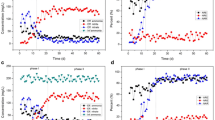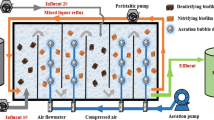Abstract
The moving bed biofilm reactors (MBBRs) were used to remove the residual NO3 −-N of wastewater treatment plant (WWTP) effluent, and the MBBR carriers for denitrification were compared. The results showed that high denitrification efficiency can be achieved with polyethylene, polypropylene, polyurethane foam, and haydite carriers under following conditions: 7.2 to 8.0 pH, 24 to 26 °C temperature, 12 h hydraulic retention time (HRT), and 25.5 mg L−1 external methanol dosage, while the WWTP effluent total nitrogen (TN) was between 2.6 and 15.4 mg L−1 and NO3 −-N was between 0.2 and 12.6 mg L−1. The MBBR filled with polyethylene carriers had higher TN and NO3 −-N removal rate (44.9 ± 19.1 and 83.4 ± 13.0 %, respectively) than those with other carriers. The minimum effluent TN and NO3 −-N of polyethylene MBBR were 1.6 and 0.1 mg L−1, respectively, and the maximum denitrification rate reached 23.0 g m−2 day−1. When chemical oxygen demand (COD)/TN ratio dropped from 6 to 4, the NO3 −- N and TN removal efficiency decreased significantly in all reactors except for that filled with polyethylene, which indicated that the polyethylene MBBR can resist influent fluctuation much better. The three-dimensional excitation–emission matrix analysis showed that all the influent and effluent of MBBRs contain soluble microbial products (SMPs)-like organics and biochemical oxygen demand (BOD), which can be removed better by MBBRs filled with haydite and polyethylene carriers. The nitrous oxide reductase (nosZ)-based terminal restriction fragment length polymorphism (T-RFLP) analysis suggested that the dominant bacteria in polyethylene MBBR are the key denitrificans.





Similar content being viewed by others

References
Abdo Z, Schüette UME, Bent SJ, Forney LJ (2006) Statistical methods for characterizing diversity of microbial communities by analysis of terminal restriction fragment length polymorphisms of 16S. Environ Microbiol 8:929–938
Adabju S (2013) Specific moving bed biofilm reactor for organic removal from synthetic municipal wastewater. University of Technology
Ahmad SR, Reynolds DM (1999) Monitoring of water quality using fluorescence technique prospect of on-line process control. Water Res 33:2069–2074
Aiken GR, Hsu-Kim H, Ryan JN (2011) Influence of dissolved organic matter on the environmental fate of metals, nanoparticles, and colloids. Environ Sci Technol 45:3196–3201
APHA, AWWA, WEF (1992) Standard methods for the examination of water and wastewater, Washington, D.C.
Asano T (2002) Water from (waste)water—the dependable water resource. Water Sci Technol 43:24–33
Asano T, Levine AD (1996) Wastewater reclamation, recycling and reuse: past, present, and future. Water Sci Technol 33:1–14
Baker A (2001) Fluorescence excitation-emission matrix characterization of some sewage-impacted rivers. Environ Sci Technol 35:948–953
Baker A, Inverarity R (2004) Protein-like fluorescence intensity as a possible tool for determining river water quality. Hydrol Process 18:2927–2945
Barker DJ, Stuckey DC (1999) A review of soluble microbial products (SMP) in wastewater treatment systems. Water Res 33:3063–3082
Barker DJ, Mannucchi GA, Sandrine MLS, Stuckey D (1999) Characterisation of soluble residual chemical oxygen demand (COD) in anaerobic wastewater treatment effluents. Water Res 33:100–110
Cao Y, Van De Werfhorst LC, Scott EA, Raith MR, Holden PA, Griffith JF (2013) Bacteroidales terminal restriction fragment length polymorphism (TRFLP) for fecal source differentiation in comparison to and in combination with universal bacteria TRFLP. Water Res 47:6944–6955
Chen H, Zheng B (2013) Sources of fluorescent dissolved organic matter in high salinity seawater (Bohai Bay, China). Environ Sci Pollut Res Int 20:1762–1771
Chen W, Westerhoff P, Leenheer AJ, Booksh K (2003) Fluorescence excitation-emission matrix regional integration to quantify spectra for dissolved organic matter. Environ Sci Technol 37:5701–5710
Chu L, Wang J (2011) Comparison of polyurethane foam and biodegradable polymer as carriers in moving bed biofilm reactor for treating wastewater with a low C/N ratio. Chemosphere 83:63–68
Coble PG (1996) Characterization of marine and terrestrial DOM in seawater using excitation-emission matrix spectroscopy. Mar Chem 51:325–346
Delnavaz M, Ayati B, Ganjidoust H (2010) Prediction of moving bed biofilm reactor (MBBR) performance for the treatment of aniline using artificial neural networks (ANN). J Hazard Mater 179:769–775
Dupla M, Comeau Y, Parent S, Villemur R, Jolicoeur M (2006) Design optimization of a self-cleaning moving-bed bioreactor for seawater denitrification. Water Res 40:249–258
Elliott S, Lead JR, Baker A (2006) Characterisation of the fluorescence from freshwater, planktonic bacteria. Water Res 40:2075–2083
Guo J, Ma F, Jiang K, Xu S, Cui D (2008) Biofilm formation on the spherical carrier of polyurethane foams treating petrochemical wastewater. Chin J Environ Eng 2:322–326
Hapeshi E, Lambrianides A, Koutsoftas P, Kastanos E, Michael C, Fatta-Kassinos D (2013) Investigating the fate of iodinated X-ray contrast media iohexol and diatrizoate during microbial degradation in an MBBR system treating urban wastewater. Environ Sci Pollut Res Int 20:3592–3606
Her J-J, Huang J-S (1995) Influences of carbon source and C/N ratio on nitrate/nitrite denitrification and carbon breakthrough. Bioresour Technol 54:45–51
Hua B, Veum K, Koirala A, Jones J, Clevenger T, Deng B (2006) Fluorescence fingerprints to monitor total trihalomethanes and N-nitrosodimethylamine formation potentials in water. Environ Chem Lett 5:73–77
Hudson N, Baker A, Ward D, Reynolds DM, Brunsdon C, Carliell-Marquet C, Browning S (2008) Can fluorescence spectrometry be used as a surrogate for the biochemical oxygen demand (BOD) test in water quality assessment? An example from South West England. Sci Total Environ 391:149–158
Hur J, Hwang S-J, Shin J-K (2008) Using synchronous fluorescence technique as a water quality monitoring tool for an urban river. Water Air Soil Pollut 191:231–243
Jarusutthirak C, Amy G (2007) Understanding soluble microbial products (SMP) as a component of effluent organic matter (EfOM). Water Res 41:2787–2793
Kelly MG (2001) Use of similarity measures for quality control of benthic diatom samples. Water Res 35:2784–2788
Kuzniz T, Halot D, Mignani AG, Ciaccheri L, Kalli K, Tur M, Othonos A, Christofides C, Jackson DA (2007) Instrumentation for the monitoring of toxic pollutants in water resources by means of neural network analysis of absorption and fluorescence spectra. Sensors Actuators B Chem 121:231–237
Labelle M-A, Juteau P, Jolicoeur M, Villemur R, Parent S, Comeau Y (2005) Seawater denitrification in a closed mesocosm by a submerged moving bed biofilm reactor. Water Res 39:3409–3417
Liu Y (1997) Estimating minimum fixed biomass concentration and active thickness of nitrifying biofilm. J Environ Eng 123:198–202
Liu C, Li J, Chen W, Chen B, Qiu B (2011) Treatment efficiency of secondary effluent by combined process of contact filtration and magnetic ion exchange resin. China Water Wastewater 27:13–15
Martina F, Giuseppe G, Gianni A (2010) Modelling respirometric tests for the assessment of kinetic and stoichiometric parameters on MBBR biofilm for municipal wastewater treatment. Environ Model Softw 25:626–632
Mases M, Dimitrova I, Nyberg U, Gruvberger C, Andersson B (2010) Experiences from MBBR post-denitrification process in long-term operation at two WWTPs. Proc Water Environ Fed 14:458–471
Odegaard H (2006) Innovations in wastewater treatment: the moving bed biofilm process. Water Sci Technol 53:17–33
Odegaard H, Mende U, Skjerping EO, Simonsen S, Strube R, Bundgaard E (2012) Compact tertiary treatment based on the combination of MBBR and contained hollow fibre UF-membranes. Desalin Water Treat 42:80–86
Reynolds DM, Ahmad SR (1997) Rapid and direct determination of wastewater BOD values using a fluorescence technique. Water Res 31:2012–2018
Rusten B, Hem LJ, Odegaard H (1995) Nitrogen removal from dilute wastewater in cold climate using moving-bed biofilm reactors. Water Environ Res 67:65–74
Rusten B, Eikebrokk B, Ulgenes Y, Lygren E (2006) Design and operations of the Kaldnes moving bed biofilm reactors. Aquac Eng 34:322–331
Scala DJ, Kerkhof LJ (1998) Nitrous oxide reductase (nosZ) gene specific PCR primers for detection of denitrifiers and three nosZ genes from marine sediments. FEMS Microbiol Lett 162:61–68
Scala DJ, Kerkhof LJ (2000) Horizontal heterogeneity of denitrifying bacterial communities in marine sediments by terminal restriction fragment length polymorphism analysis. Appl Environ Microbiol 66:1980–1986
Shen Z, Zhou Y, Hu J, Wang J (2013) Denitrification performance and microbial diversity in a packed-bed bioreactor using biodegradable polymer as carbon source and biofilm support. J Hazard Mater 250–251:431–438
Spellerberg IF (2008) Shannon–Wiener index. In: Fath SEJD (ed) Encyclopedia of ecology. Academic, Oxford, pp 3249–3252
Stinson B, Peric M, Neupane D, Laquidara M, Locke E, Murthy S, Bailey W, Kharkar S, Passarelli N, Derminassian R, Carr J, Sultan M, Shih G, Barnard J, Daigger G, Parker D, Randall C, Wilson T (2009) Design and operating considerations for a post denitrification MBBR to achieve limit of technology effluent NOx < 1 mg/l and effluent TP < 0.18 mg/l. Nutrient Removal, 1225–1254
Vilar-Sanz A, Puig S, Garcia-Lledo A, Rosalia Trias BMD, Js C, Ls B (2013) Denitrifying bacterial communities affect current production and nitrous oxide accumulation in a microbial fuel cell. PLoS ONE 8:1–11
Wei Z, Hu Y, Fang P (2011) Performance of a ceramic moving bed biofilm reactor for treatment of low strength sewage. Acta Sci Circumst 31:46–53
Welander U, Henrysson T, Welander T (1998) Biological nitrogen removal from municipal landfill leachate in a pilot scale suspended carrier biofilm process. Water Res 32:1564–1570
Westerhoff P, Mezyk SP, Cooper WJC, Minakata D (2007) Electron pulse radiolysis determination of hydroxyl radical rate constants with Suwannee River fulvic acid and other dissolved organic matter isolates. Environ Sci Technol 47:4640–4646
Zekker I, Rikmann E, Tenno T, Lemmiksoo V, Menert A, Loorits L, Vabamae P, Tomingas M, Tenno T (2012) Anammox enrichment from reject water on blank biofilm carriers and carriers containing nitrifying biomass: operation of two moving bed biofilm reactors (MBBR). Biodegradation 23:547–560
Zhu G, Yin J, Zhang P, Wang X, Fan G, Hua B, Ren B, Zheng H, Deng B (2014) DOM removal by flocculation process: fluorescence excitation–emission matrix spectroscopy (EEMs) characterization. Desalination 346:38–45
Acknowledgments
This study was supported by the National Major Science and Technology Program for Water Pollution Control and Treatment (2014ZX07216-001). The authors also appreciate support from the Research Center for Water Pollution Control Technology at Chinese Research Academy of Environmental Sciences and China Scholarship Council Foundation (2011911098).
Author information
Authors and Affiliations
Corresponding author
Additional information
Responsible editor: Angeles Blanco
Rights and permissions
About this article
Cite this article
Yuan, Q., Wang, H., Hang, Q. et al. Comparison of the MBBR denitrification carriers for advanced nitrogen removal of wastewater treatment plant effluent. Environ Sci Pollut Res 22, 13970–13979 (2015). https://doi.org/10.1007/s11356-015-4546-z
Received:
Accepted:
Published:
Issue Date:
DOI: https://doi.org/10.1007/s11356-015-4546-z



